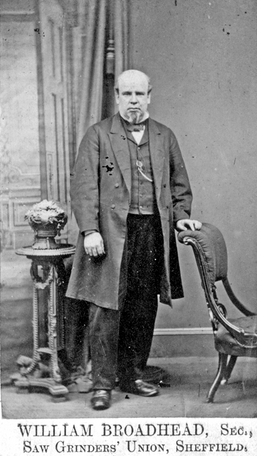In this series of blog posts we will pick out a selection of stories from our city’s past and hopefully whet your appetite for more. You can delve deeper by visiting our website and view thousands of images at Picture Sheffield, the city’s depository of over 100,000 local images.
The Sheffield Outrages
Throughout the nineteenth century, the working population of Sheffield was growing rapidly and workers campaigned for better rights and conditions. There were calls for political, economic and social reform throughout the period, pushed back by resistance from an establishment reluctant to change.Despite them being illegal, trade union membership and activity grew during the period. Sheffield was a hive of union activity and one of its main centres during the 1860s. In fact, at the height of the industrial revolution in the city, with conditions dangerous and wages low, organisation and solidarity was often a matter of life and death.
Saw grinding in Sheffield. Taken from 'The Working Man, Feb. 3rd, 1866
The struggle for union rights against the opposition of employers involved occasional violence and subsequent repression, culminating in the brutal Sheffield Outrages of 1866-7. The outrages were a series of murders and other intimidations against those who did not comply with union rules. Thomas Fearnehough, who was accused of taking on unlawful apprentices, had a can of gunpowder thrown into his cellar, and James Linley, accused of the same crime, was shot dead while at the Crown Inn on Scotland Street.
The Crown Inn, c 1917. Where James Linley was shot during the Outrages of of the 1860s
The proprietor of The Sheffield Telegraph, William Leng, called for a full investigation into the outrages and a Royal Commission was set up to look at the issue of trade unions. It concluded that William Broadhead, General Secretary of the Saw Grinder’s Union, was responsible for ordering the outrages, including murder.
Although the Royal Commission was hostile towards the trade unions, some of the commission’s members were sympathetic and wrote a minority report, recommending that unions be recognised. Just a few years later this report was the basis of the Trade Union Act of 1871, which legalised unions for the first time.
Population of Sheffield in 1861 - 219,634
Tomorrow, we leap forward into the 20th Century and look at the story of the Sheffield Pals, and their fate at the Battle of the Somme.





No comments:
Post a Comment
Please leave your comments (subject to moderation).